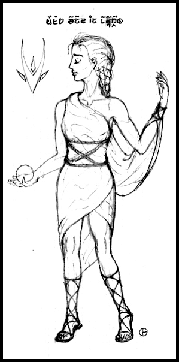
Appearance and Anatomy
All Obrenaj display deeply indigo blue eyes, full lips and a naturally athletic physique. Skin and hair color vary with geographic location.
 The majority of the Obrenje population belongs to the grassland type ("Pelevni"), with a golden mediterranean tan, sometimes with subtle freckles along prominent areas of the body, and straight blonde hair. In the alpine province of Viskatro, lighter caucasian skin tones prevail, while black or a very dark brown are the most common hair colors. The hair can be slightly wavy. In the desert province of Casan, skin tones concentrate into a rich cocoa brown, mostly accompanied by lustrous copper-brown hair.
The majority of the Obrenje population belongs to the grassland type ("Pelevni"), with a golden mediterranean tan, sometimes with subtle freckles along prominent areas of the body, and straight blonde hair. In the alpine province of Viskatro, lighter caucasian skin tones prevail, while black or a very dark brown are the most common hair colors. The hair can be slightly wavy. In the desert province of Casan, skin tones concentrate into a rich cocoa brown, mostly accompanied by lustrous copper-brown hair.
Goatees are fairly popular among men, but larger beards are hardly ever seen. Both sexes may wear their hair long or short, though long hair, usually braided or bound at the back of the head, is more popular among women. Clean-shaven scalps are commonly worn by many men outside of Viskatro, and even by a few Casanje women.
Being very social people by nature, the Obrenaj prefer to spend their free time together, such as on parties, in team sports, orchestras, choirs etc, or simply on a mind-freeing jogging trip.
Music
Music is the most popular art form, especially when sung, and is practices in many different styles, ranging from venerable classical works such as Dostajar's monumental thunderous choir compositions or Azilani's romantic vocal duets to the rhythmic dance music of the grasslands or the improvised singing of a circle of friends under a hot summer night's sky.
Food
The highlights of Obrenje cuisine include lotso, a sort of burrito with a multitude of possible fillings such as lemon-fried garlic shrimps and noodles, or spicy chicken and rice, or yoghurt and berries.
Obrenaja's favorite morning drink is drazno, an aromatic hot beverage brewed from the three-lobed drazno nut, tasting a bit like caramel and bitter almonds. It grows in the grassland regions and makes a good trading product.
Roseberries are about grape-sized and grow in the temperate and alpine regions. They are pleasant to eat make an excellent rosy wine. Iceberries are the ugly cousins of roseberries, growing in the hotter parts of Obrenaja. Their flesh is a milky translucent white and very sour, but popular as a cooking ingredient or in the form of lemonade.
Animals
The Obrenaj domesticate a number of animal species, the following ones being the most common:
 The obrovon, or king antelope, is a cousin to the common shandix. Due to its horns, it can be a dangerous animal to ride, but once accustomed to a rider, it makes an excellent swift riding animal. It can develop remarkable affinities for its rider, allowing them to communicate on a low empathic level.
The obrovon, or king antelope, is a cousin to the common shandix. Due to its horns, it can be a dangerous animal to ride, but once accustomed to a rider, it makes an excellent swift riding animal. It can develop remarkable affinities for its rider, allowing them to communicate on a low empathic level.
Windhounds, a local breed of dogs, can be trained to understand a wide range of commands, and are used for herding and guarding purposes.
The hovering manta is a rather stupid animal, with limited use as message couriers (like homing doves), but their main value is that they look cute and calming, with their slow idle aerial swimming movements (though they can dart away pretty quickly in a pinch). Children love them.
Sexuality
The Obrenaj have a quite liberal take on sexuality, which could be mistaken for promiscuity by more conservative cultures. Premarital sex is not considered immoral, but indeed advisable: To marry as virgins is considered rash and foolhardy, like buying an expensive stock of wine without having tasted it. Romantic Love is considered an art form. Suffice it to say that the Obrenje language distinguishes at least eight types of kissing....
A widely available contraceptive plant extract (the "Bitter Tea") helps them avoid unwanted pregnancies.
Warfare
Obrenaj are careful about their lives, and are often accused by foreigners of being cowardly. This does not, however, mean that they are unskilled in the art of war. The traditional weapons of Obrenaja are the knife, the sabre, the staff, the naginata, the two-handed sword, the bow/crossbow, the weighted chain, the felles, the nitsha (a punch-dagger also used for parrying), and the sales.
Felles are long-handled curved swords primarily optimized for slashing, though the tip is well aligned with the handle, so it should also be pretty useful for thrusting. The name means "woman's sword", since the design was allegedly first invented by the legendary Obrenje blacksmith Atreja Caron ur Galinja for his daughter Zeandri.
